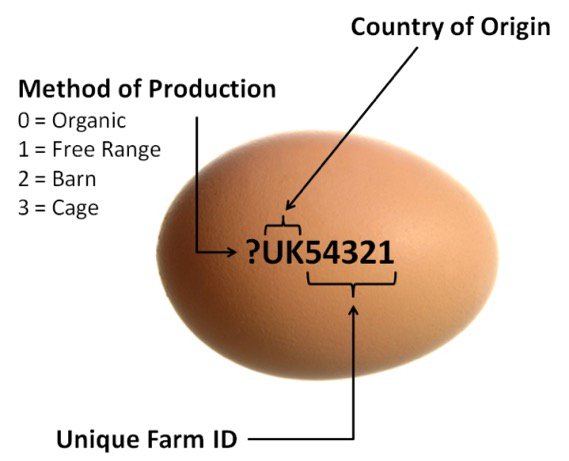Did you know that in the EU eggs have a code stamped that allow us to know how the chicken was treated?
Egg marking in the European Union (EU) is a comprehensive system designed in 2004 to provide consumers with information about the production method and origin of eggs. This system plays a crucial role in ensuring transparency and traceability within the egg industry, allowing consumers to make informed choices based on factors such as animal welfare and production practices.
The EU egg marking system involves a specific alphanumeric code that is applied to each egg or its carton. This code carries valuable information, and decoding it reveals details about how the eggs were produced and where they originated. The primary components of the EU egg code include the production method code, country code, farm identification number, and packaging date.
1. Production Method Code: The first digit of the code represents the production method used for the eggs. The following codes are used:
- 0: Organic farming method
- 1: Free-range farming method
- 2: Barn farming method
- 3: Caged farming method
This aspect of the code is instrumental in communicating to consumers the conditions under which the hens were raised, addressing concerns related to animal welfare and ethical farming practices.
2. Country Code: Following the production method code is a two-letter country code, representing the EU member state where the eggs were produced. For instance, “UK” stands for the United Kingdom, “DE” for Germany, and “FR” for France. This component helps consumers identify the geographic origin of the eggs, supporting preferences for locally produced goods or adherence to specific quality standards associated with certain regions.
3. Farm Identification Number: The next segment of the code is the farm identification number. This unique identifier allows for traceability back to the specific farm where the eggs were laid. This aspect of the code is crucial for quality control, monitoring, and ensuring compliance with regulations. It also facilitates accountability within the supply chain, as any issues related to egg safety or quality can be traced back to the source.
4. Packaging Date: The final part of the code is the packaging date, indicating when the eggs were packed. This information is valuable for consumers who prioritize freshness and want to make informed decisions about the age of the eggs they purchase.
The EU egg marking system is an essential tool in addressing consumer concerns regarding food safety, animal welfare, and ethical farming practices. By providing clear and standardized information, it empowers consumers to align their purchasing choices with their values. For example, individuals who prioritize organic farming methods can easily identify and choose eggs with a production method code of 0, while those seeking free-range options can look for a code starting with 1.

This system also contributes to the overall integrity of the egg industry by promoting transparency and accountability. Farmers, producers, and distributors are incentivized to adhere to regulations and maintain high standards, knowing that the information encoded on each egg is accessible to consumers and regulatory authorities.
It’s important to note that while the EU egg marking system is standardized, variations may exist based on specific national regulations or additional quality assurance schemes. Therefore, consumers should be aware of the nuances in egg markings and stay informed about any updates or changes to regulations.
In conclusion, the EU egg marking system serves as a model for transparent and informative labeling within the food industry. By providing consumers with detailed information about the production method and origin of eggs, it supports their ability to make choices aligned with their values and preferences. This system not only contributes to consumer confidence but also fosters a culture of responsibility and compliance within the egg production and distribution chain.


